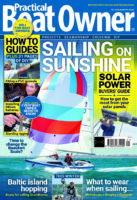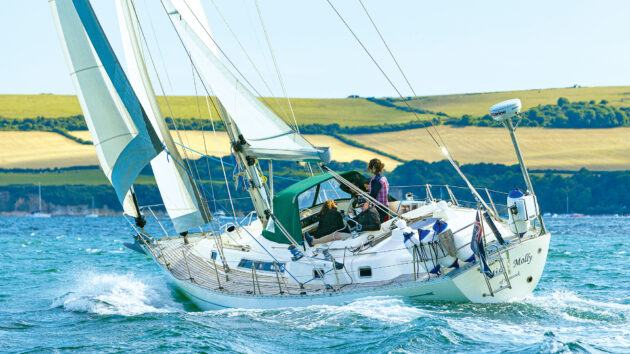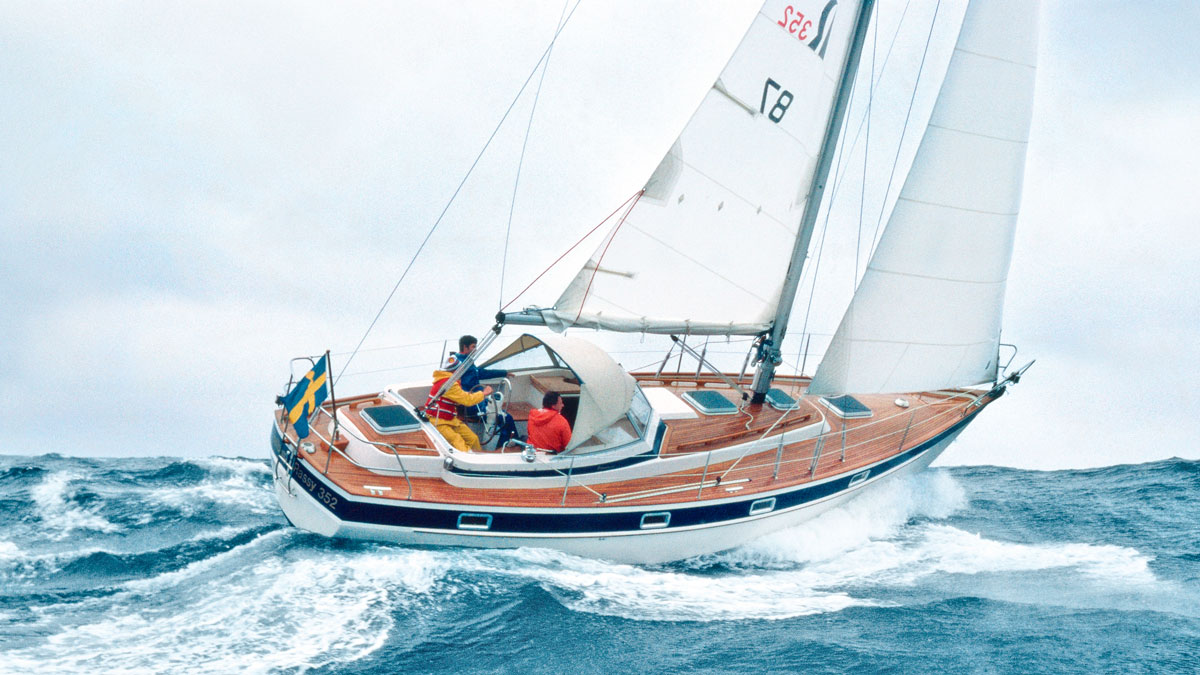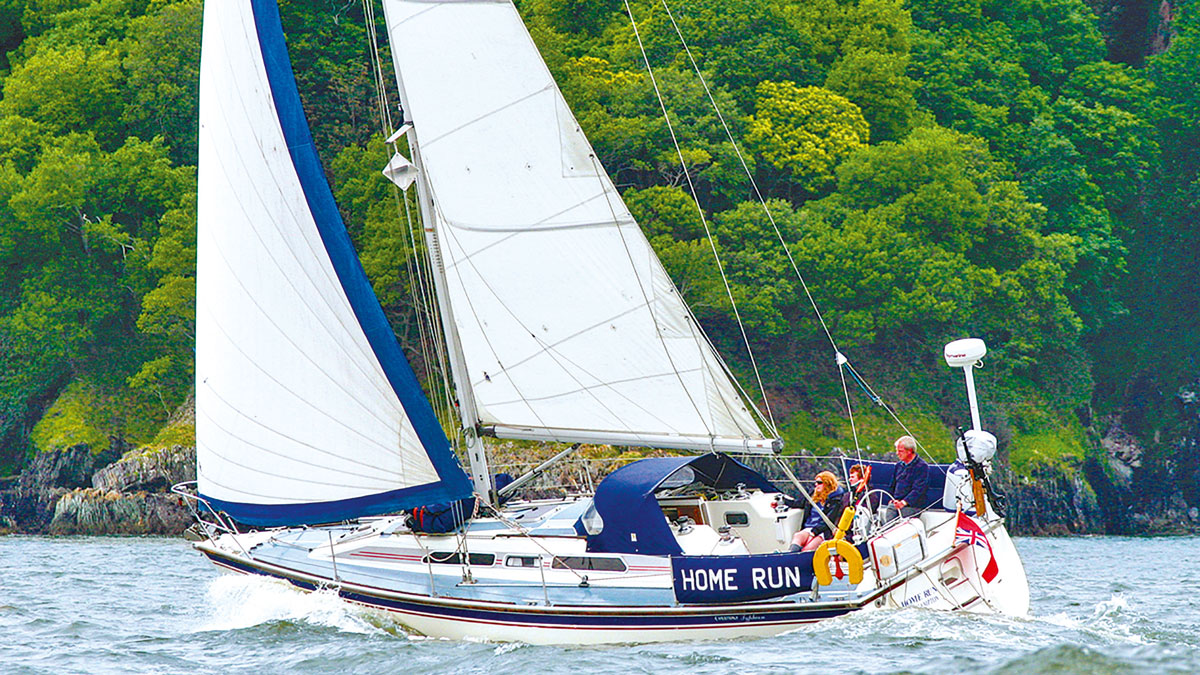Rupert Holmes looks at a selection of comfortable and capable centre cockpit cruising yachts with big owner’s suites and a large guest cabin. Models: Oyster 406 | Hallberg-Rassy 42E | Scanmar 40 | Westerly Oceanlord | Bowman 40 Contest 42 | Nicholson 39 | Moody 425 | Amel Sharki.
Lovers of the Oyster 406 and other centre cockpit concepts will know that the style has largely died out among smaller and mid-size yachts.
Yet it remains very popular in larger sizes, where boatbuilders including Oyster and Contest, continue to produce centre cockpit designs from 50ft to more than 80ft; Hallberg-Rassy is one of the few remaining yards building centre cockpit designs as small as 40ft.
The Oyster 406
The Oyster 406 is a very civilised option from the 1980s for those who plan to spend a lot of time living on board and is now relatively affordable.
It’s one of three centre cockpit Holman and Pye designs that created new expectations for space, comfort, and build quality in what was then considered to be the upper end of the market. Collectively, they helped to firmly establish Oyster’s name as one of the best builders of yachts of this size.
At the time, all were seen as large yachts that marked a massive improvement in both life on board and style compared to the marque’s earlier cruising yachts. The Oyster 435 was the most popular of the trio, with 65 boats sold between 1983 and 1995, while 25 of the larger Oyster 46 were sold between 1982 and 1990.
The smaller Oyster 406 was built between 1986 and 1990, with just 35 boats completed.
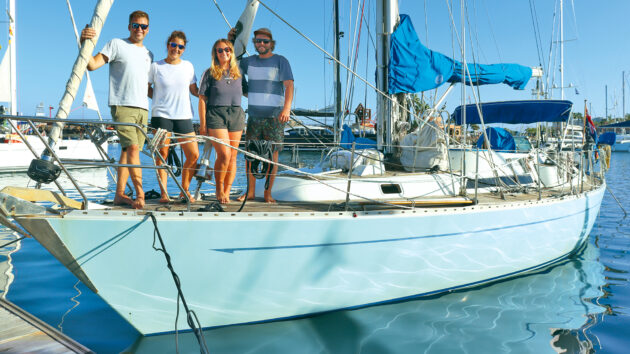
The Oyster 406 was sold with either a traditional coachroof or a deck saloon. Photo: Heather Prentice.
The Oyster 406 was available with either a traditional coachroof or a deck saloon and is the smallest Oyster ever produced in that format.
Seating in the comfortable, bright and spacious saloon wasn’t raised to provide a view outside, but the concept of combining the deck saloon with a hull shape that would satisfy experienced sailors who value good manners and fast passage times was such that the company now produces no other type of boat.
Unlike its larger siblings, the 406 was only ever offered with a two-cabin layout, but the centre cockpit configuration allowed for a spacious and private owner’s suite aft. In later examples, this has a large centreline double berth, but on early boats it was offset to starboard.
A very good double guest cabin forward, with a second heads and shower compartment, plus plenty of stowage, adds to the attraction.
There’s also a proper navigation station and an excellent galley located in the walkthrough to the aft cabin. This has around 3m of worktop, plenty of stowage and is configured to function well both at anchor and under way.
The accommodation uses almost the full length of the hull and was a revelation in its day, with the relatively high freeboard increasing the feeling of space below decks, while also creating a drier ride at sea.
Since then, hull shapes have changed enormously, and today’s yachts of a similar size have far more internal volume, especially aft.
On the downside, handling under power is not as crisp as with newer designs, especially in reverse.
Equally, relatively heavy displacement translates to a larger rig, making sail handling a more energetic activity.
However, this is a boat that will lie more comfortably and quietly at anchor than more recent, lighter designs.
Although only a small number of boats were built, many Oyster 406s have successfully undertaken long voyages, including circumnavigations.
Oyster 406
LOA: 12.34m/40ft 6in
LWL: 10.59m/34ft 9in
Beam: 3.89m/12ft 9in
Draught (standard): 1.75m/5ft 9in
Displacement: 9,299kg/20,500lb
Contact: www.oysteryachts.com
Hallberg-Rassy 42E
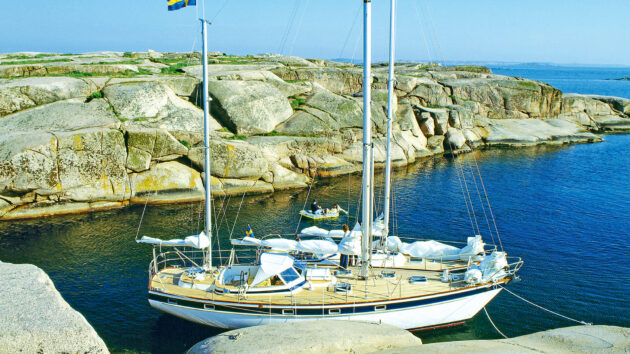
The Hallberg-Rassy 42E’s high freeboard means accommodation down below is spacious. Photo: Hallberg-Rassy.
In most sectors, the expensive, high-end market sees fewer sales than mainstream mid-market products. However, this long-established Swedish boatbuilder has been bucking the trend for decades. This distinctive 42ft centre cockpit cruiser, designed by Christoph Rassy and Olle Enderlein, sold 252 units over 11 years starting in 1980.
The 42E was intended as a serious long-distance cruising yacht, with a flush deck, fixed windscreen for shelter and a ketch rig. A sloop rig with a 1.4m (4ft 7in) taller mast was subsequently offered as an option and became almost universal on later boats, reflecting advances in sail handling equipment during the 1980s.
The high freeboard needed to create good headroom in a flush-deck cruising yacht significantly adds to the internal volume, and the accommodation is spacious compared to similar-sized yachts of this era, while the interior joinery was first class.
Nevertheless, despite the slightly longer hull length, the waterline length and beam are marginally smaller than those of the Oyster 406.
Overall, the layout is very similar to that of the Oyster 406 and Westerly Oceanlord, though with a spacious and well-appointed U-shape galley to starboard of the companionway.
This is easier to descend than that of the Westerly, but with the drawback that there’s less floor area at the foot of the companionway.
The en suite aft cabin has two berths, with maximum dimensions of 2m x 1.35m and 2m x 0.71m, and maximum headroom of a shade over 6ft.
The entire area forward of the mast can be used as a big en suite cabin with very generous stowage, or with a day head to port and the smaller forecabin area closed off.
Hallberg-Rassy had already turned to renowned Argentinian naval architect Germán Frers for the design of the HR45 in 1988 and the HR36 the following year. Both boats were very well received, so he was the natural choice for the all-new HR42F that succeeded the 42E in 1991.
Hallberg-Rassy 42E Specifications
LOA: 12.93m/42ft 4in
LWL: 10.50m/34ft 6in
Beam: 3.78m/12ft 5in
Draught (standard): 2.05m/6ft 9in
Displacement: 11,500kg/25,353lb
Contact: www.hallberg-rassy.com
Scanmar 40
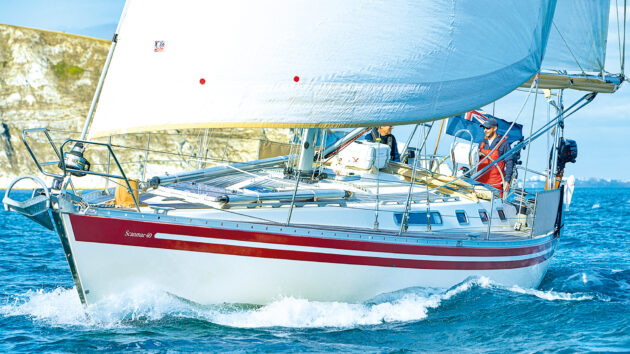
The Scanmar 40’s keel-stepped mast is supported by two sets of in-line spreaders and forward and aft lowers. Photo: David Harding.
This is an interesting option for anyone wanting a capable and fast cruising yacht with a very high build quality.
Only 20 boats were built between 1986 and the early 1990s, but don’t let that put you off – there are plenty of examples of well-designed and well-built yachts that were not commercially successful in their day, yet remain very desirable yachts.
The Scanmar 40 is a Swedish-built Rolf Magnusson design that offers a surprisingly good aft owners’ cabin with a centreline bed and en suite facilities for an aft cockpit boat.
The saloon is a good size and there is a proper forward-facing navigation station, with a smart swivelling seat. However, the galley and forecabin are smaller than those of most other boats in this selection.
In common with many designs of this era, there’s a big overlapping genoa that requires effort to sheet home after every tack; inevitably, it sets badly when partially furled in stronger winds, increasing heel and weather helm.
However, these problems can be solved by replacing the genoa with a jib of around 105-110% and adding a Code 0 reaching sail set on separate furling gear.
With this setup, you can expect an easily handled and fast boat that is rewarding to sail, especially if the mainsail is set up to be reefed from the cockpit.
Scanmar 40 Specifications
LOA: 12.24m/40ft 1in
LWL: 10.40m/34ft 1in
Beam: 3.85m/12ft 7in
Draught: 2.00m/6ft 6in
Displacement: 7,500kg/16,535lb
Westerly Oceanlord
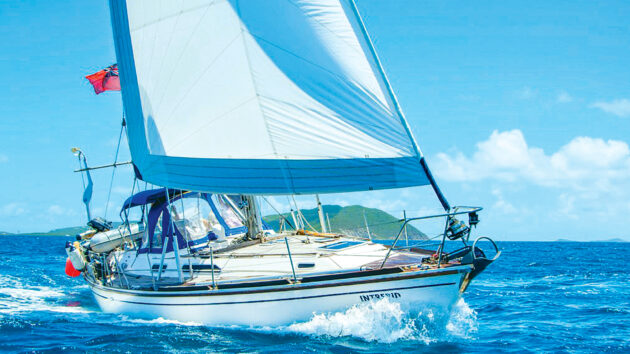
The Westerly Oceanlord looks sleeker than other models from the yard and was produced from 1987 to 2000. Photo: Andy Gibb.
Westerly may not have the cachet of Hallberg-Rassy or Oyster, but this 40ft 6in centre cockpit model offers spacious two-cabin, two-heads accommodation in a similar overall format. It was a development of the Ed Dubois-designed 38ft 6in Sealord launched in 1983, but with modified and elongated aft sections; the mould was cut just aft of the cockpit and an extra 15in grafted into the middle of the boat.
This created a more spacious owner’s cabin aft, with the extra volume towards the middle of the boat transforming this area compared to the Sealord. An extra 9in was also added aft, enabling Westerly to create its first ’sugar scoop’ transom, with an integrated bathing platform. Importantly, this is also a big help in boarding from a dinghy, though it is not as good as later designs that benefit from a walk-through transom arrangement.
It has a sleeker and more powerful shape than is generally associated with Westerlys, though the draught of 1.7m (5ft 6in) is more modest than that of later designs of similar length, and the keel’s chord length is greater.
Extending the boat’s overall length also helped boost waterline length, while displacement increased by around a tonne compared to the Sealord.
However, sail areas are similar, so the Oceanlord may be slower in light airs, though when the breeze picks up, the longer waterline will come into play and give the newer model a definite edge.
In earlier years, Westerly had made extensive use of internal glassfibre mouldings to speed the interior fitting-out process. However, by the 1980s Westerly went back to a more traditional approach, and much of the interior is hand-built from marine plywood faced with quality veneers, along with substantial capping pieces. This resulted in a traditional style and quality that appeals to many.
For those accustomed to newer yachts, the companionway is surprisingly steep and a long way down from the cockpit, though there’s scope for owners to tweak the arrangement should they wish.
Once below decks, there is a lovely, spacious L-shaped galley, a big navigation station and a large saloon that includes a lot of stowage.
The walk-through to the aft cabin houses a single berth (or Pullman-style bunks) that can make excellent sea berths. The en suite aft cabin is spacious, but the maximum headroom is slightly limited. There is good stowage and a settee to port, while the double berth is offset to starboard; however, this isn’t particularly wide at the foot end. Later versions had a more modern and wider centreline peninsula double berth.
Ahead of the saloon is a day heads/shower that is the en suite for the forward double guest cabin, and there’s further stowage opposite.
The good-sized guest cabin has adequate standing space aft of the double vee-berth and reasonable stowage.
The centre cockpit format means the cockpit feels quite small and is well forward, while on-deck stowage is primarily in a deep cockpit locker.
Many examples were ordered with the optional teak decks, but if these have not already been removed or replaced, extensive maintenance may be needed.
The Oceanlord was introduced in 1987 and remained in production until the firm ceased trading in 2000. It proved to be a relatively popular model, with 112 boats sold – not far off three times the number of Sealords that were built.
Westerly Oceanlord Specifications
LOA: 12.34m/40ft 6in
LWL: 10.74m/35ft 3in
Beam: 4.12m/13ft 6in
Draught: 1.68m/5ft 6in
Displacement: 9,470kg/20,878lb
Contact: www.westerly-owners.co.uk
Bowman 40
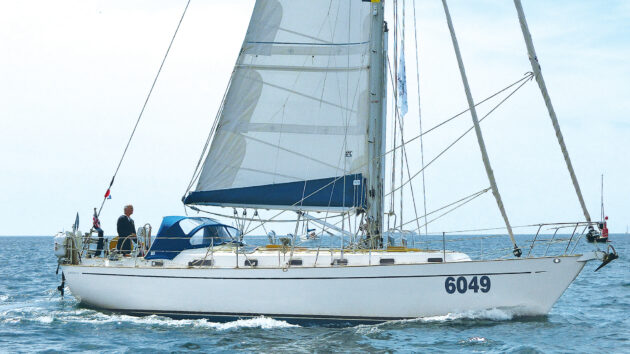
Most Bowman 40s were built with cutter rigs, which helps to keep sails manageable for short-handed crews. Photo: Mervyn Wheatley.
This was the first of four designs by American naval architect Chuck Paine for Southampton-based Bowman Yachts.
The Bowman 40 was considered one of the best British-built cruising yachts of its era, though it is a more conservative option than the Oyster 406 and was only available in an aft cockpit layout. Indeed, Paine has described it as “a very conservative moderate draught design.”
Still, it quickly gained a strong following, and many sailors of the day would have been very happy to have one appear in their Christmas stockings. Some boats have made notable oceanic voyages, and owners can expect a very solid feel at sea, plus good performance when reaching and downwind in a decent breeze.
Modest sail area and the Scheel keel’s shallow draught limit performance to windward and in light airs, however.
The keel’s very long cord length confers excellent directional stability, but this comes at the expense of easy manoeuvring in port.
At this time Bowman had an excellent reputation for build quality and joinery was completed to a very high standard. The boat was built to order, and owners specified small internal differences, so few examples are exactly alike.
Below decks, the boat has a spacious, two-cabin, two-heads arrangement, with a proper chart table and excellent galley with ample worktop space and stowage. The forecabin is by far the larger cabin and is effectively en suite, although later boats gained a larger berth in the quarter cabin.
Almost 60 boats were built between 1984 and the late 1990s, when this model was replaced by the Bowman 42. This was a modification of the original design, with an extended counter stern creating more stowage aft and giving the boat a sleeker appearance.
This model was also offered with two new keels, with 2.0m (6ft 6in) or 1.7m (5ft 9in) draught, as an alternative to the original very shallow draught Scheel keel; however, it’s believed only around 10 examples of this version were built.
Bowman 40 Specifications
LOA: 12.10m/40ft 0in
LWL: 9.80m/32ft 0in
Beam: 3.80.45m/4ft 9in
Displacement: 9,700kg/21,400lb
Contact: www.rivalowners.org.uk
Contest 42
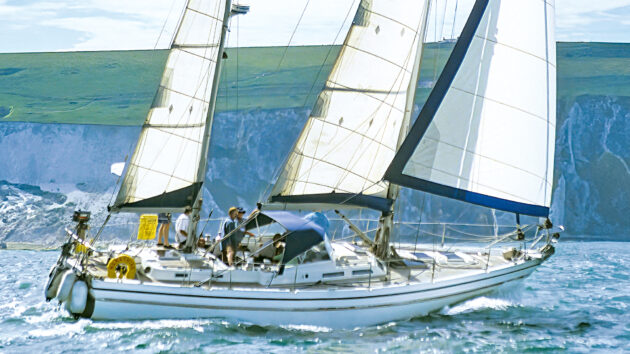
The Contest 42 is a stiff boat that needs a good blow to get her going. Photo: David Harding.
This Dick Zaal-designed centre cockpit ketch is a slightly older model, and 32 were built between 1977 and 1984. It was intended as a spacious, capable and comfortable serious cruiser, yet was also ahead of its time in many respects, with a walk-through passageway to the aft cabin that helps confer what was at the time a surprising feel of space below decks.
The Contest 42 also helped cement this Dutch boatbuilder, which was originally founded to build the Olympic Flying Dutchman dinghy in the late 1950s, as a quality builder of first-class serious cruising yachts.
It retains that position today, along with yards such as Oyster, and is still in the same family ownership.
These qualities were already recognised by many in the international marine industry. For instance, David Sadler, of Sadler Yachts fame and designer of the Contessa 26 and 32, chose a Contest 42 for long-distance cruising in his retirement.
It’s a heavier boat than most of the others in this selection and has less sail area, so light airs performance suffers, though the boat has an excellent reputation in heavy weather. It was also offered with a choice of either a conventional folding spray hood or a fixed wheelhouse arrangement.
The interior was designed to be both efficient and ergonomic at sea and comfortable in port or at anchor, and follows a similar pattern to later similar-sized centre cockpit designs. Headroom is particularly notable at 1.95m (6ft 5in) or more. As befits a yacht designed for long-distance use, tankage is generous, with a capacity for 425lt of fuel and 1,000lt of fresh water.
Contest 42 Specifications
LOA 13.00m 42ft 7in
LWL 10.00m 23ft 8in
Beam 4.00m 13ft 1in
Draught 1.85m 6ft 1in
Displacement 12,430kg 27,400lb
Contact: www.contestyachts.com
Nicholson 40
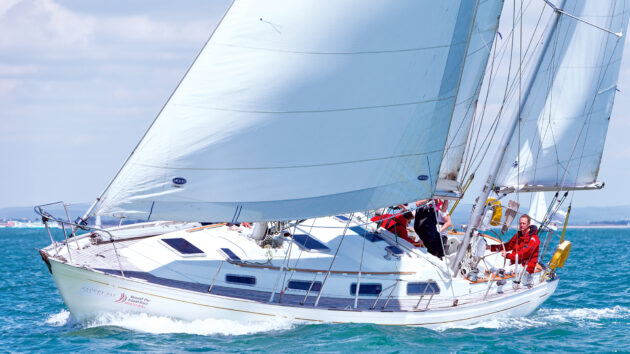
The Nicholson 40 was available in both aft cockpit and deck saloon variants. Photo: David Harding.
In many respects, this was a yard that set standards others had to follow, almost from the advent of large-scale glassfibre boatbuilding. For example, the Nicholson 32, designed in 1961-62, was an extremely successful long-keel cruiser, with more than 370 boats built over a period of 20 years, and numerous updates to the design.
By contrast, the Nicholson 55 of 1969 was an enormously successful ocean racing yacht, with several completing Whitbread Round the World races, while the Nicholson 70 of a similar era was one of the most luxurious and comfortable big yachts of its time.
The Nicholson 39 was born of this thinking in 1975 and was a supremely comfortable boat for its era, and very well built. It also has a similar centre cockpit layout with en suite cabins fore and aft, but a narrower beam and longer overhangs result in less internal volume than for other boats in this selection.
The Nicholson 40 was launched just three years later and is believed to be a development of the 39, with an extra foot added to the hull mould. It was offered as an aft cockpit model with ketch or sloop rig and either a conventional coachroof or a deck saloon.
Nicholson 40 Specifications
LOA: 12.2m/40ft 0in
LWL: 9.3m/30ft 6in
Beam: 3.51m/11ft 6in
Draught: 1.75m/5ft 9in
Displacement: 11,000kg/24,250lb
Moody 425
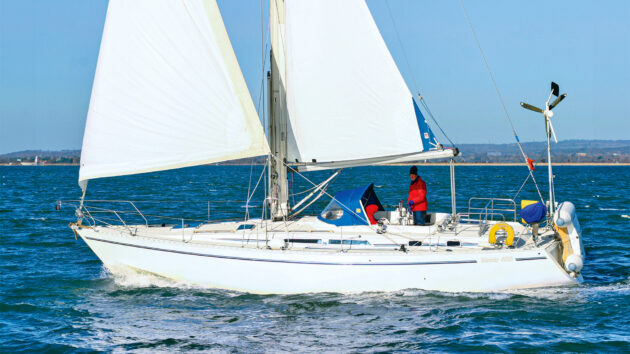
In-mast furling came as standard on the Moody 425. Photo: David Harding.
When new, this Bill Dixon-designed boat was a direct competitor to the Oyster 406, arguably offering equal or better accommodation at a lower price.
Launched in 1988 it was based on the earlier Moody 422, with the transom extended to allow two additional on-deck lockers. In addition the en suite for the aft cabin gained access from the galley. These proved to be popular changes, and 116 boats were sold over three years, compared to 72 Moody 422s built between 1986 and 1988.
Like other models in Moody’s range of family cruisers, both boats offered spacious accommodation at an attractive price, but the 422 was the first of its size to have a central double bed in the aft cabin. Otherwise, the layout is similar to that of the Oyster 406, but with twin berths in the passageway between the saloon and aft cabin. This area can be closed off to form an additional guest cabin if required.
The simple, but robust, double-spreader masthead rig was fitted with in-mast furling as standard from new on the 425, although a slab reefing mainsail was standard on the earlier model.
Two keel options were also offered: a standard (1.8m) draught fin and a shoal (1.4m) option. The 425 was replaced with the Moody 44, which continued in production until 1996.
Moody 425 Specifications
Hull length 12.70m 41ft 8in
LWL 10.44m 34ft 3in
Beam 4.07m 13ft 4in
Draught (std keel) 1.83m 6ft 0in
Displacement 9,900kg 21,780lb
Contact: www.moodyowners.org
Amel Sharki
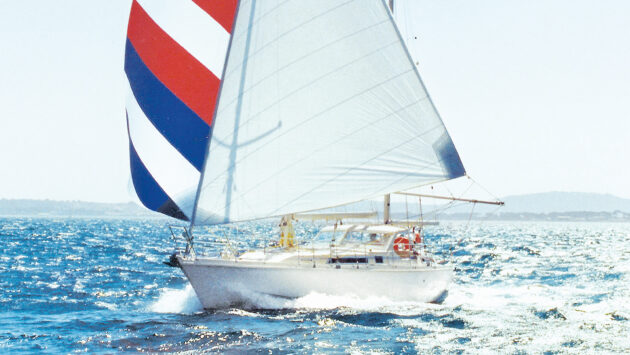
Rather than a teak deck, Amel used a teak effect pattern in the Sharki’s deck moulding. Photo: Amel.
Henri Amel was a perfectionist who didn’t see why long-distance cruising should be uncomfortable or hard work.
These convictions, coupled with his extensive sea time, led to the development of no-nonsense, serious long-distance cruising yachts built by his yard in La Rochelle.
Ketch rigs split the sail plan into easily handled areas, and in heavy weather the boats sail well with only the mizzen and staysail. Similarly, there’s a deep centre cockpit, sheltered steering position and deep bulwarks that promote security when working on deck.
A lack of external woodwork might suggest a cost-cutting approach to boatbuilding, but nothing could be further from the truth. This was a decision that benefits owners in the long term, thanks to significantly reduced maintenance and no unexpected mammoth bills for replacing end-of-life teak decks.
Instead, as standard, Amel’s boats tended to be equipped to a very high level. This makes absolute sense from a production engineering standpoint: if every boat is the same, it’s easier to maintain consistent quality and quickly learn if something doesn’t work.
The result is a high level of reliability, and the yard enjoyed an enviable reputation long before YouTube stars Sailing Delos set out on their lengthy circumnavigation on a 54ft Amel Super Maramu.
From 1979, 200 Amel Sharkis were built over 10 years, making this one of the most popular centre cockpit designs of its period, outselling the Oyster 406 and Westerly Oceanlord combined.
However, it’s an earlier design than these boats, with less internal volume and this results in reduced space in both sleeping cabins, a smaller galley and a lack of en suite facilities for the aft cabin.
Amel Sharki Specifications
LOA: 11.95m/39ft 2in
LWL: 9.75m/32ft 0in
Beam: 3.60m/11ft 10in
Draught: 1.75m/5ft 9in
Displacement: 9,700kg/21,400lb
Contact: www.amel.fr
Rupert Holmes has sailed 85,000 miles in more than 250 different boats. He won the 2022 Sevenstar non-stop round Britain and Ireland race and is currently preparing for the Globe 40 double-handed round the world race.
Second hand focus: Hallberg Rassy 352 + 8 alternative yachts to consider
Rupert Holmes celebrates the attributes of this iconic, but expensive, Scandinavian design and highlights other options
Comparing the Westerly Typhoon 37 and 6 other designs
Rupert Holmes looks at the the Westerly Typhoon 37, his favourite Westerly model of all time, and other alternative boats…
Want to read more articles like this?

A subscription to Practical Boat Owner magazine costs around 40% less than the cover price.
Print and digital editions are available through Magazines Direct – where you can also find the latest deals.
PBO is packed with information to help you get the most from boat ownership – whether sail or power.
-
-
-
- Take your DIY skills to the next level with trusted advice on boat maintenance and repairs
- Impartial, in-depth gear reviews
- Practical cruising tips for making the most of your time afloat
-
-
Follow us on Facebook, Instagram, TikTok and Twitter

